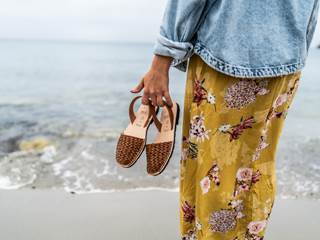I'm a very curious person. I love researching, learning new things, and reading interesting facts... I know some of you are like me, because we've received several messages on our social media asking us the correct way to spell the names of our beloved Menorcan women: avarca? abarca? or even albarca? Well, we've decided to dedicate today's post to clarifying this matter.
Menorca's typical summer sandals, the Menorcan avarcas, incorrectly called Ibizan sandals, originate from the island's rural landscape. In ancient times, Menorca's rocky landscape required durable and flexible footwear for farmers and stonemasons, who made their own shoes from whatever leather and rubber they had available, which was none other than reused tires that were no longer suitable for vehicles.
However, there are numerous variations of the abarcas in Spain, called "albarcas" or "abarcas," and they are arguably one of the oldest forms of footwear in our country. Most are used only as traditional footwear for folklore performances. Here are some of them:
- Basque albarca : Made of rawhide, this is a more closed shoe that covers the sole, toes, sides, and heel of the foot in a single piece. It has the peculiarity of being closed with a bag-like gather, with a leather strap or cord of any material, which also interlaces the instep and calf. Source: Wikipedia
- Calzaera : This is one of the oldest, most primitive and crudest albarcas known today. They were widely used in the Central System, from the province of Cáceres to the Sierra Norte of Madrid. Especially popular in the province of Ávila, the calzaera consists of a rectangular piece of cowhide (formerly raw), with a series of holes arranged on the sides of the foot that were tied using a cord made of leather, sheep gut, hemp, linen or even Torvisquera bark, without a hoof.
- Wheeled sandals : This is one of the best-known sandals throughout the Iberian Peninsula, especially south of the Cantabrian coast. This sandal is made with a recycled tire sole and closes over the toes to the middle of the instep. It has a piece in the toe or heel. It closes with another strap above the instep, secured with a buckle. The materials used for the sole can range from leather to plastic. Originally, this sandal was made entirely of leather. This type of "closed" sandal made with a tire sole began to become widespread in the first and second quarters of the 20th century with the proliferation of automobiles and motorcycles, and was especially used in the post-war period. They are characterized by their flexibility, their low cost of manufacture, and the strength and durability of the sole.
The Avarca of Menorca
However , the one that has endured the longest over time due to its adaptation to fashion and public needs is the iconic Menorcan avarca. Its popularity quickly led to the emergence of imitators, so measures were taken to protect it. In 2010, the Menorca Island Council approved regulations and registered the Avarca de Menorca trademark.
Thus, although the RAE (Royal Spanish Academy of Language) defines the concept “abarca” as “leather or rubber footwear that covers only the sole of the feet and is secured with strings or straps over the instep and ankle,” the word “avarca” is also correct, as it has a protected geographical indication that allows the use of the term to refer to the Avarca of Menorca.
So, as you can see, all three forms, avarca, abarca, and albarca are correct, but to refer to our beloved Avarca of Menorca, it is best to use the term as you have just read, AVARCA.
We hope you enjoyed it and it satisfied your curiosity!

